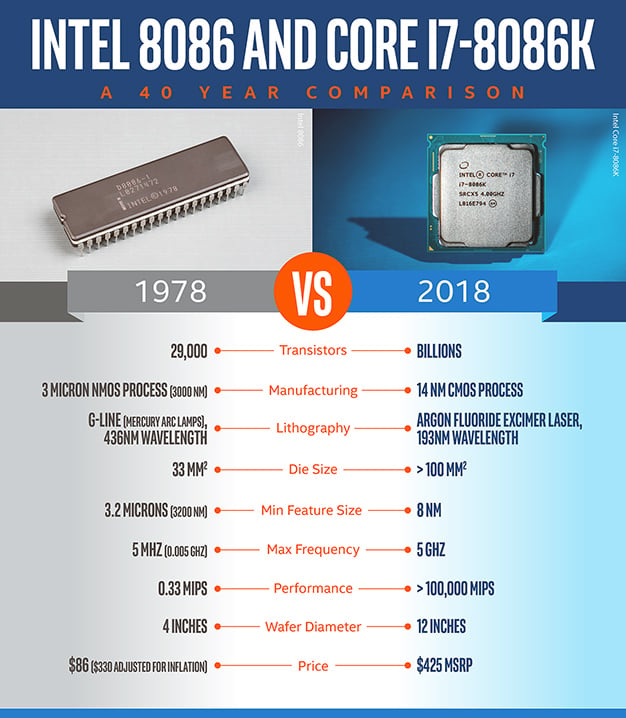Core i7-8086K 40th Anniversary CPU Review: Intel X86 Hits 5GHz
Intel Core i7-8086K: Everything You Need To Know
Intel recently launched a Core i7-8086K Limited Edition processor, based on the company’s Coffee Lake architecture, to commemorate the 40th anniversary of the venerable 8086. Although it wasn’t the first microprocessor employed in personal computers, the Intel 8086 laid the foundation for the x86 architecture, which has been at the core of virtually all “IBM compatible” or “Win-Tel” PCs released since.
Before we talk about where Intel is going with Core i7-8086K, however, we need to discuss where it has been. Intel put together this infographic highlighting the major advancements made in processor design and manufacturing over the last 40 years. As you can see, the transistor count is simply incomparable. The massive increase in transistor count was enabled by huge leaps made in the manufacturing (and design) processes. Whereas the 8086 was manufactured using a 3 Micron process – equivalent to 3,000nm – the Core i7-8086K is manufactured using a 14nm process. Larger wafers are also in use today and the die used in the 8086K is about 3x larger. Clocks have obviously ramped-up significantly as well. The 8086 chugged along at roughly 5MHz; the Core i7-8086K’s peak turbo frequency is 1000x higher at 5GHz.
Of course there have been many architectural tweaks made over the years and we can’t forget core counts either. All told, save for parts of its instruction set, there are very few similarities between the original 8086 and 8086K, but we’d be remiss not to point out that even today’s processors are technically compatible with some of the software written all the way back in the early days of x86. That is a feat in and of itself.
The Intel Core i7-8086K looks exactly like the Coffee Lake-based Core i7-8700K. They utilize the same packaging and materials, etc. Intel has, however, selectively binned the dies in the 8086K in an effort to boost performance and efficiency somewhat.

This table outlines the technical differences between the Core i7-8700K and Core i7-8086K. As you can see, nothing really changes except for the max, single-core turbo frequency and the standard operating frequency. The cache configurations, graphics engine, TDP, etc. are all unchanged – more on this later though.

If we break down the actual turbo clocks on a per-core basis, the differences are even less stark. The Core i7-8086K offers a single-core, max turbo frequency of 5GHz, but multi-core turbo clocks are unchanged. What that means is, single-threaded workloads may perform somewhat better on the Core i7-8086K versus the 8700K, but multi-threaded workloads that tax more of the processor’s resources should perform similarly.
Before we dive into the actual numbers, here’s what the Core i7-8086K looks like according to CPU-Z. Like the 8700K, the Core i7-8086K is a 6C/12T beast. As mentioned, it has a base clock of 4GHz and a max boost clock of 5GHz. There is 12MB of Intel Smart Cache onboard, along with Intel UHD 630 series graphics and support for an array of technologies, like Optane Memory, AVX2, QuickSync, etc. The stepping and revision of the chip are also the same as the 8700K.










